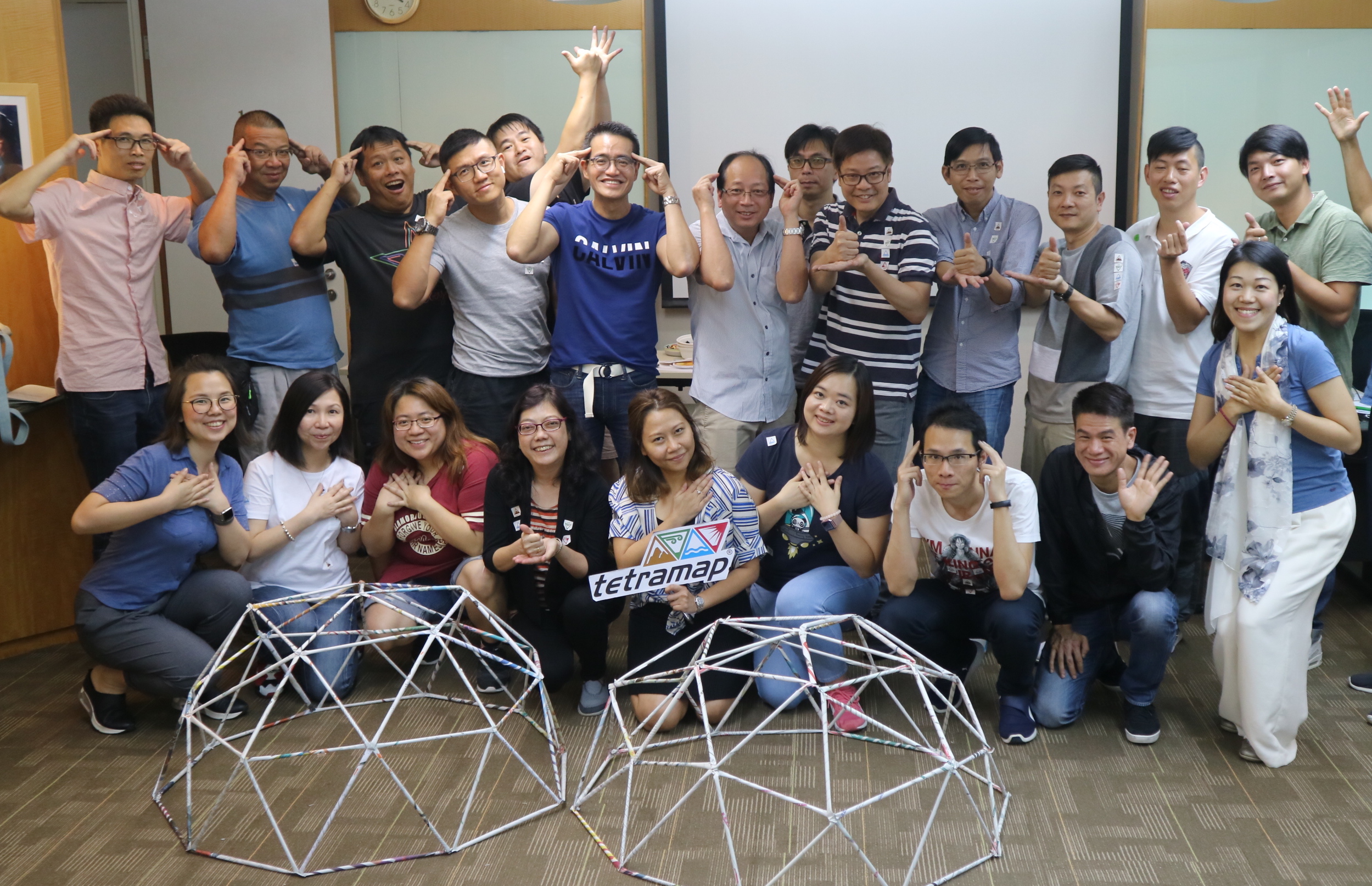Extended learning after
teambuilding
 by Vivien Hui, Certified TetraMap Facilitator, Essentia, Hong Kong
by Vivien Hui, Certified TetraMap Facilitator, Essentia, Hong Kong
Teambuilding events are essential as it helps to create better team relationship and should be designed to have both serious business and personal impact.
Very often we finish a day of teambuilding with such high energy and team spirit, everyone feeling energized and engaged, committing to be different, to be better, to be more considerate as a team member.
Nothing changes
What really happened was, when they go back to the same office, when they meet the same colleagues, when they walk into the same meeting room, the feeling at ‘that moment’ just vanished… It is not a secret and it is always a big challenge for teambuilding facilitators to try to extend the “learning” after a long day of fun team activities.
The root cause
After taking part (conduct and attend) in teambuilding event with the purpose of enhancing communication for and with more than thousands of participants, I found the root of the problem could be:
- The debriefing had focused on WHAT happened but not WHY it happens
- There is no HOW to do better in a structured way, and so it is almost impossible to
recall for action - The teambuilding experience was fun and able to create shared memory
within the team, but the debriefing is too general.
My study of TetraMap® had opened the horizon of teambuilding design and delivery. With its experiential and discovery-based learning methodology, I had attempted to use the model to do 2 things and had proven to work in one of my client programs for 180 participants:
Use TetraMap® to design the teambuilding program, make sure that the
design is all-rounded and structured:
- EARTH – Define the objective of the program and the activity. What does the client want to achieve through the experiential learning session?
- AIR – What are the flow and steps in conducting the activity? How are we going to utilize the time given and balance the game time with the debriefing/learning reflection? How are we going to give a clear instruction to the participants?
- WATER – What are the roles in the activity, what should be the team size and how can we engage all the team members during the activity.
- FIRE – What are the different level of difficulties of the activity? Are there any variations where we can fit into different situations? How can we advance or improve the material or structure used in the activity?
Use TetraMap® to facilitate the debriefing, some examples as below:
- EARTH (to look at the goal and achievement) – Did the team achieve the objective and target of the activity? What had you done differently in round 1 and round 2? What was the key message brought out by the activity?
- AIR (to make sense of the situation and look into the process) – What are the different role in the activity? Recall the process of the activities, how did the team do it? Had you observed and experienced anything which surprised you or impressed you?
- WATER (to show caring and share feelings) – How are you feeling about the team and yourself during the activity? Please appreciate any team members who supported you during the activity by a shoulder tap.
- FIRE (to explore possibilities and inspire others) – If you got a chance to do the activity again, what would you do differently to make the result even better?
What would be the ONE KEY element which you would recall when you are back to your workplace? Or, something you would like to share with those who are not in today’s activity?
I found the beauty of TetraMap® to be its possibilities to be inserted into or work together with other programs and tools which can help to strengthen whatever your expertise lays. For teambuilding facilitators, I urge you to explore new activities and new ways to debrief using TetraMap®.
Let’s make learning extendable even after days, weeks and months of fun and engaging teambuilding day.
Please share your thoughts and feedback. I would love to hear your views and perspectives.
Thank you, Vivien Hui
Essentia Corporate Development Limited
+852 97558283

Comments
Leave a Reply
You must be logged in to post a comment.

Vivien, thanks for sharing. The root cause reminds me of the Golden Circle of “Why, How and What” in the book “Start with Why” by Simon Sinek. People must know their purpose the “Why”, the process of the “How” to realize the why and the result for Why with “What” do you do.
I like your design for the TBTL programme, especially the debriefing points using Tetramap to facilitate. I will try to incorporate it with ALP (Action Learning Process of Bar, Dar and Par) in my next TBTL debrief.
Very insightful Vivian. All of us will extend and leverage learning big time when we apply it to any team endeavour: Review goals; Make sense of; Share feelings; Explore possibilities. Like Nature, an elegant and efficient system.
Absolutely Yoshimi, and with the meaning nature brought us, TetraMap has help us and our team to learn in efficient way by its beautifully and effectively designed framework! Thank you for your comment!
Thanks for this blog Vivien – its really timely and I can see that I will benefit from applying your thoughts to my work. I recently ran a workshop on building a geodesic dome …. and I felt that I could have run the debrief to have more impact for the team. I am going to use your model for the next workshop I deliver and debrief!
Thank you Anna and really glad to know that you found it useful 🙂
Do let me know how do you feel using it and feel free to let me know if there is any concept to add on! Cheers.
Thank you Vivien, and I agree. All too often the de-brief is somewhat casual, whereas your steps provide a thorough plan and concrete review. Asking participants to write down their answers before discussing makes the experience even more concrete. After reading this, I thought of a 4 ‘D’ Elements – Design, Deliver, Debrief and Demonstrate.
Nicely done and great sharing of your expertise in this area.
Thank you for your comment Louise! Yes, a proper debrief can make the learning much long lasting and meaningful! The 4D Elements is great, I’ll take the challenge to build the second level in TetraMap using it! Thanks again 🙂